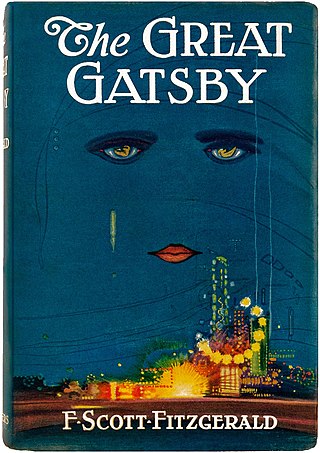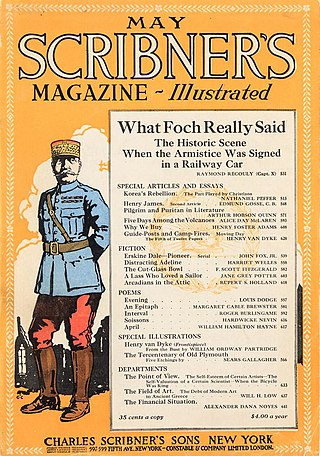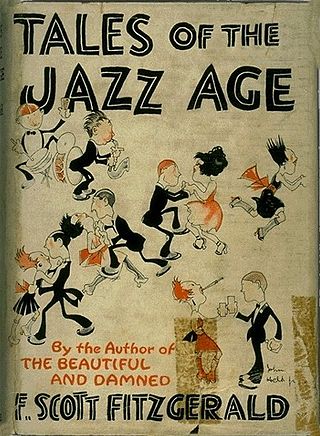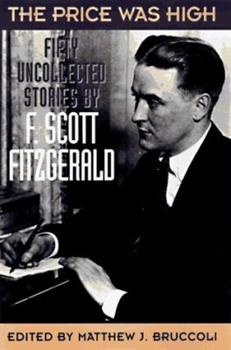
The Great Gatsby is a 1925 novel by American writer F. Scott Fitzgerald. Set in the Jazz Age on Long Island, near New York City, the novel depicts first-person narrator Nick Carraway's interactions with Jay Gatsby, the mysterious millionaire with an obsession to reunite with his former lover, Daisy Buchanan.

Zelda Fitzgerald was an American novelist, painter, and socialite. Born in Montgomery, Alabama, to a wealthy Southern family, she became locally famous for her beauty and high spirits. In 1920, she married writer F. Scott Fitzgerald after the popular success of his debut novel, This Side of Paradise. The novel catapulted the young couple into the public eye, and she became known in the national press as the first American flapper. Because of their wild antics and incessant partying, she and her husband became regarded in the newspapers as the enfants terribles of the Jazz Age. Alleged infidelity and bitter recriminations soon undermined their marriage. After Zelda traveled abroad to Europe, her mental health deteriorated, and she had suicidal and homicidal tendencies, which required psychiatric care. Her doctors diagnosed her with schizophrenia, although later posthumous diagnoses posit bipolar disorder.
Matthew Joseph Bruccoli was an American professor of English at the University of South Carolina. He was an expert on F. Scott Fitzgerald; his biography of Fitzgerald, published in 1981, was considered the standard biography for decades. He also wrote about other writers, including Ernest Hemingway, Thomas Wolfe, and John O'Hara, and was editor of the Dictionary of Literary Biography.

This Side of Paradise is a 1920 debut novel by American writer F. Scott Fitzgerald. It examines the lives and morality of carefree American youth at the dawn of the Jazz Age. Its protagonist, Amory Blaine, is a handsome middle-class student at Princeton University who dabbles in literature and engages in a series of unfulfilling romances with young women. The novel explores themes of love warped by greed and social ambition. Fitzgerald, who took inspiration for the title from a line in Rupert Brooke's poem Tiare Tahiti, spent years revising the novel before Charles Scribner's Sons accepted it for publication.

Flappers and Philosophers is a collection of eight short stories by American writer F. Scott Fitzgerald, published in 1920 by Charles Scribner's Sons. Each of the stories had originally appeared, independently, in either The Saturday Evening Post,Scribner's Magazine, or The Smart Set.

"The Cut-Glass Bowl" is a short story by American author F. Scott Fitzgerald, first published in the May 1920 issue of Scribner's Magazine, and included later that year in his first short story collection Flappers and Philosophers. The story follows the lives of a married couple, Evylyn and Harold Piper, through various difficult or tragic events that involve a cut glass bowl they received as a wedding gift. In a copy of Flappers and Philosophers which he gave to literary critic H. L. Mencken, Fitzgerald wrote that he deemed the story to be "worth reading" in contrast to others in the volume which he dismissed as either "amusing" or "trash."

"Head and Shoulders" is a short story by F. Scott Fitzgerald. It was his first story to be published in the Saturday Evening Post, with the help of Fitzgerald's agent, Harold Ober. The story appeared in the February 21, 1920 issue and was illustrated by Charles D. Mitchell. It later appeared in his short story collection Flappers and Philosophers.

Babylon Revisited and Other Stories is a collection of ten short stories written between 1920 and 1937 by F. Scott Fitzgerald. It was published in 1960 by Charles Scribner's Sons.

"Winter Dreams" is a short story by F. Scott Fitzgerald first published in Metropolitan magazine in December 1922 and collected in All the Sad Young Men in 1926. The plot concerns the attempts by a young Midwestern man to win the affection of an upper-class socialite. Frequently anthologized, the story is regarded as one of Fitzgerald's finest works for evoking "the loss of youthful illusions."

"The Ice Palace" is a modernist short story written by F. Scott Fitzgerald and published in The Saturday Evening Post on May 22, 1920. It is one of eight short stories originally published in Fitzgerald's first collection, Flappers and Philosophers, and is also included in the collection Babylon Revisited and Other Stories.

Tales of the Jazz Age (1922) is a collection of 11 short stories by American writer F. Scott Fitzgerald. Divided into three separate parts, it includes one of his better-known short stories, "The Curious Case of Benjamin Button". All of the stories had first appeared, independently, in either Metropolitan Magazine, The Saturday Evening Post, Smart Set, Collier's, the Chicago Sunday Tribune, or Vanity Fair.

Francis Scott Key Fitzgerald, widely known simply as Scott Fitzgerald, was an American novelist, essayist, and short story writer. He is best known for his novels depicting the flamboyance and excess of the Jazz Age, a term he popularized in his short story collection Tales of the Jazz Age. During his lifetime, he published four novels, four story collections, and 164 short stories. Although he achieved temporary popular success and fortune in the 1920s, Fitzgerald received critical acclaim only after his death and is now widely regarded as one of the greatest American writers of the 20th century.

Ginevra King Pirie was an American socialite and heiress. As one of the self-proclaimed "Big Four" debutantes of Chicago during World War I, King inspired many characters in the novels and short stories of Jazz Age writer F. Scott Fitzgerald; in particular, the character of Daisy Buchanan in The Great Gatsby. A 16-year-old King met an 18-year-old Fitzgerald at a sledding party in Saint Paul, Minnesota, and they shared a passionate romance from 1915 to 1917.

All the Sad Young Men is a collection of short fiction by American writer F. Scott Fitzgerald. The stories originally appeared independently in popular literary journals and were first collected in February 1926 by Charles Scribner's Sons.

"The Offshore Pirate" is a short story written by F. Scott Fitzgerald in 1920. It is one of eight short stories included in Fitzgerald's first published collection, Flappers and Philosophers. The story was first published in the May 29, 1920 issue of The Saturday Evening Post and illustrated by Leslie L. Benson.
"The Freshest Boy" is a short story by American writer F. Scott Fitzgerald. It was first published in the July 28, 1928 issue of The Saturday Evening Post, and was reprinted in Fitzgerald's 1935 collection, Taps at Reveille.

The Basil and Josephine Stories is a collection of two separate short stories collections by F. Scott Fitzgerald which initially ran serially in The Saturday Evening Post. Some of them were later collected in Taps at Reveille and posthumous short story collections. The title characters were intended by Fitzgerald to meet each other, but this never happened in his literature. Basil Duke Lee, who was a fictionalized version of F. Scott Fitzgerald's younger self. Scott draws from his own experiences as a child and an adolescent.
"First Blood" is a short story by F. Scott Fitzgerald, originally published in the April 5, 1930 issue of The Saturday Evening Post, illustrated by Harry Russell Ballinger. It was later included in his 1935 short story collection Taps at Reveille.
"Myra Meets His Family" is a work of short fiction by F. Scott Fitzgerald first appearing in The Saturday Evening Post on March 20, 1920. The story was collected in The Price Was High: Fifty Uncollected Stories by F. Scott Fitzgerald (1979) by Harcourt, Brace & Company "Myra Meets His Family" was among the first stories accepted by The Saturday Evening Post for publication. Fitzgerald would sell the bulk of his short fiction to the Post during the next 20 years, until his death n 1940.

The Price Was High: Fifty Uncollected Stories by F. Scott Fitzgerald is a volume of short fiction by F. Scott Fitzgerald published by Harcourt Brace & Company in 1979.


















